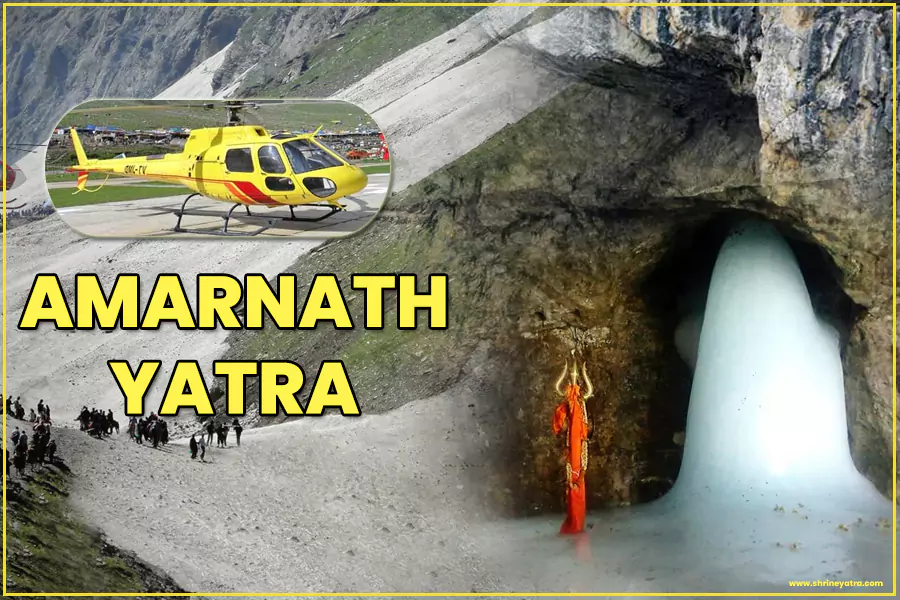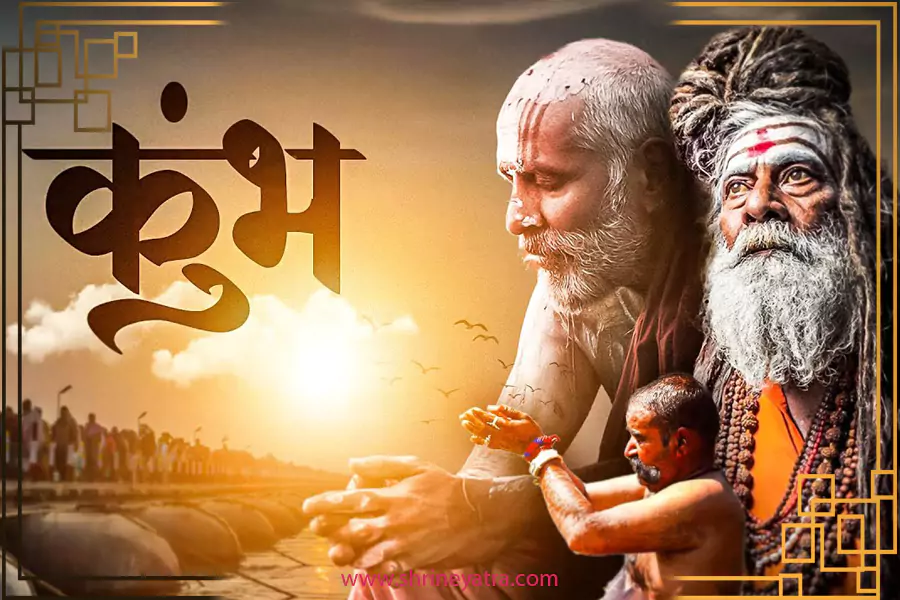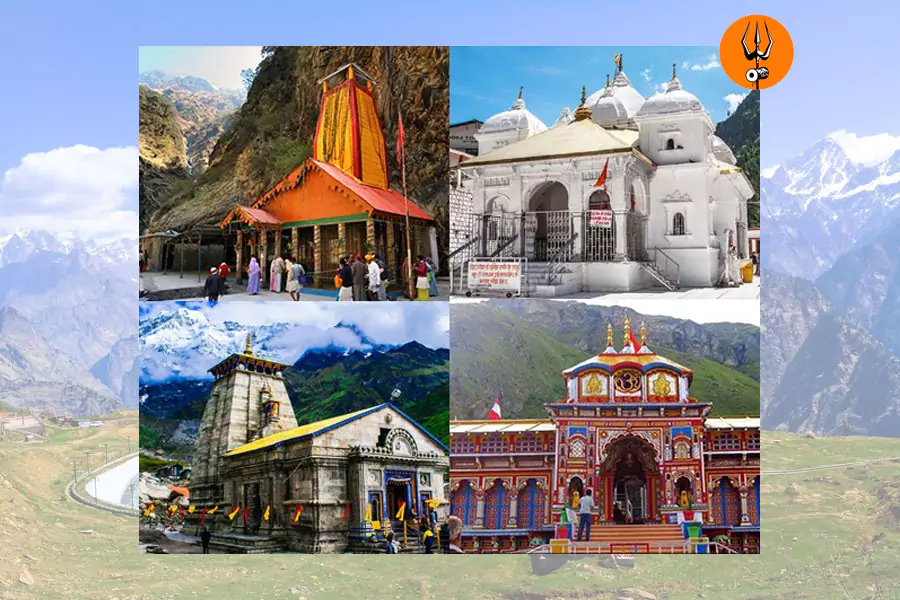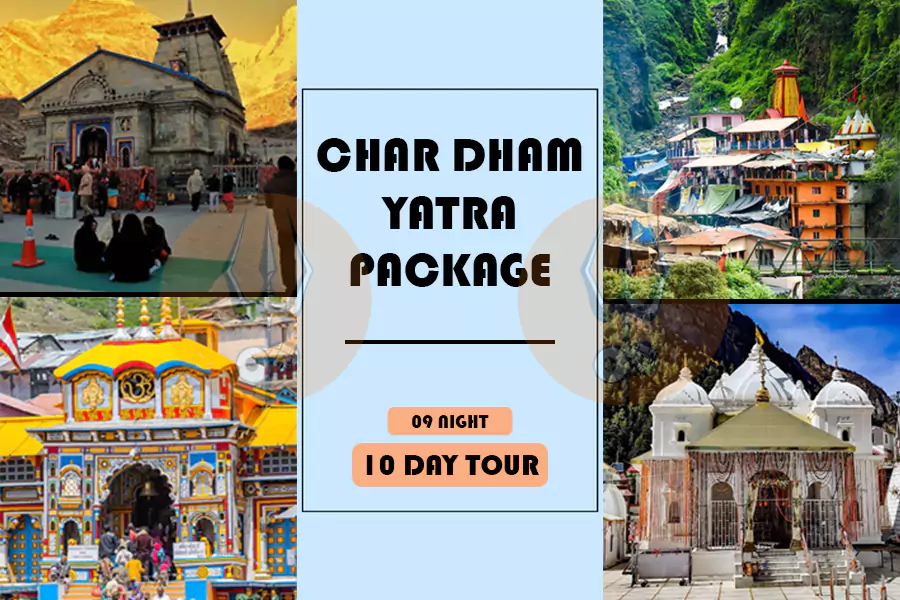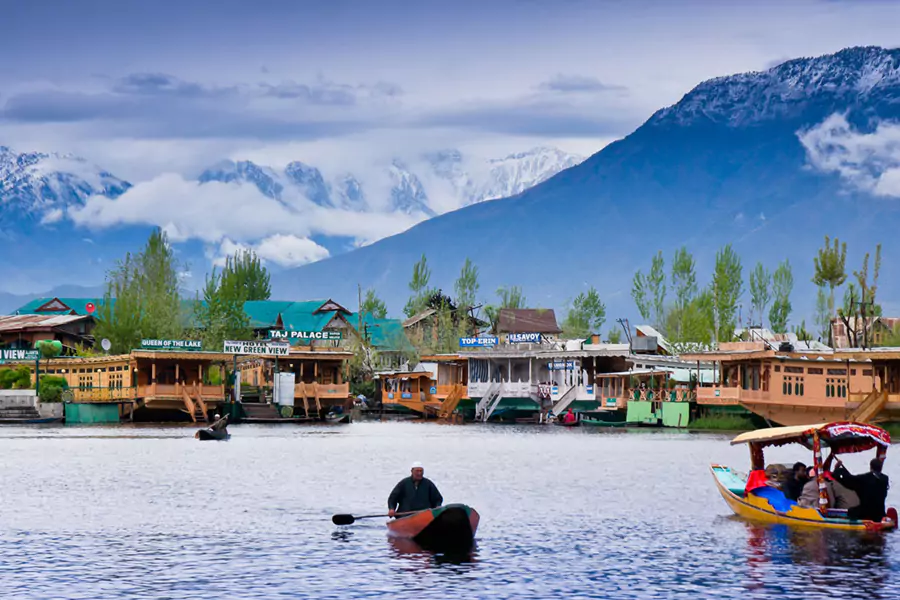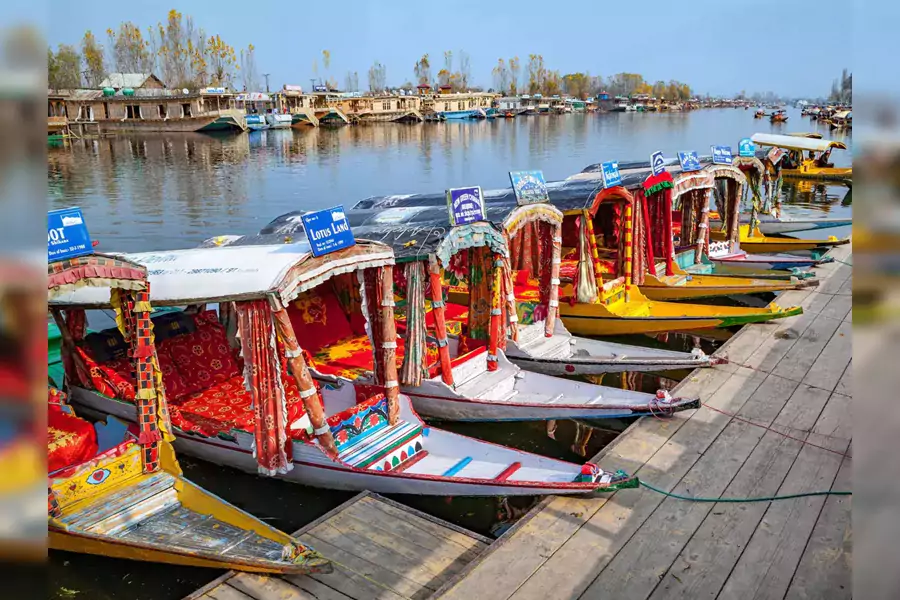What would you picture first in your mind when you think about Ujjain!! It would be nothing but the Kumbh Mela, of course. It is true that one almost immediately associates Ujjain with the Kumbh Mela. One more is also true that there is no pilgrimage greater than the Kumbh Mela on earth. At the time of the Kumbh Mela that Ujjain turns into a vast ocean of devotees, worshippers, and tourists. They visit Ujjain, just for one purpose – to have a dip in the holy Kshipra River and pray to the gods to free them of all the past sins that they might have committed. But Ujjain is much more than the Kumbh Mela. It is called the City of Temples, because of the various temples that are spread all over Ujjain. Ujjain is one of the most sacred cities that ever existed in India. There is something in the air and water of Ujjain that makes it such a special place of pilgrimage. Read on and find out every facet that makes Ujjain such a sacred city in India.
Ujjain and Simhastha Kumbh Mela
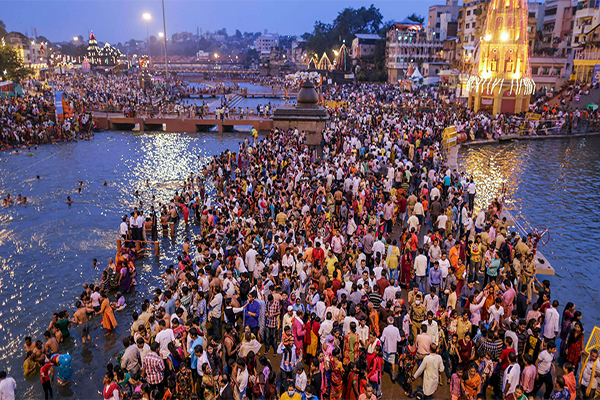
There is a very big reason why Ujjain is so sacred. And it is because of the Kumbh Mela. Ujjain is one of the places where drops of Amrit (the drink of immortality) fell from the pot or Kumbh that Lord Vishnu carried with him when he flew across the heavens. Ever since this celestial event, Ujjain has become a legendary city with immense spiritual and religious significance. The Kumbh Mela which is held in Ujjain is also known by the name of Ujjain Kumbh Mela. The reason why it is also called Simhastha Kumbh Mela is that Jupiter enters the astrological sign of Leo at this time of the year. This is considered to be a very auspicious event in the Hindu astrological context. The Kumbh Mela is a multi-cultural event where sadhus, sages, ascetics, mystics, yogis, and spiritual masters come in large numbers to bathe and worship on the banks of the Kshipra River. The Ujjain Kumbh Mela is one of the biggest reasons why Ujjain is so sacred.
Read More: Prayagraj Kumbh Mela 2025
Ujjain in the Vedas and Puranas
The ancient Indian religious texts have mentioned Ujjain several times. Ujjain is among the great places where the ancient Indian scriptures were composed. Ujjain finds mention in the ancient Hindu text, the Atharva Veda, which is the last of the holy Hindu scriptures. One finds the mention of Avanti in the various verses of the Vedas. Skanda Purana gives a vivid and detailed description of Avantipura, which was the old name of Ujjain in ancient times.
Ujjain and Its Many Names
If there is any city that is described with innumerable names, then it is none other than Ujjain. It was referred to with different names but each one of these pointed to just one city and that is Ujjain. These names are the living testimony of the illustrious history and legacy that Ujjain is bestowed. Indeed, every name has a story behind it, and every story is linked to a particular epic. These stories relate to different timelines in the history of Ujjain.
- Ujjayini: This name of Ujjain comes from the fact that Lord Shiva fought with the demon Tripura at this place. Tripura was a mighty demon who received the boon from Lord Brahma as being invincible. Lord Shiva and Tripura fought in the Avanti region which is present-day Ujjain. Lord Shiva defeated Tripura and the gods hailed it as Ujjayini, meaning mighty victory. Thus, Ujjayini is another name for Ujjain.
- Kushasthali: This name comes from grass, which is called ‘Kush’ in Sanskrit. Lord Brahma found Ujjain to be very suitable for Lord Vishnu, and he made a seat made of Kusha grass. Thus the name of Ujjain is called Kushasthali.
- Avanti: This is one of the most popular names of Ujjain. It is also called Avantika, Avantipuri, Avanti Nagri, and Avantikapuri. The story goes that once the danavas (demons) defeated the devas (gods) in a battle. The gods approached Lord Brahma for protection. Lord Brahma told them to go to Kushasthali and pray to Lord Shiva. The gods once again went to swarga. As Lord Vishnu had protected the devas in Ujjain, it is also called Avantikapuri or Avanti. Avan means ‘The Protector’ in the Sanskrit language. Another version is that Avanti was the son of the Haihaya ruler Kartavirya Arjun, who ruled over Mahismati, which was the mythological kingdom of present-day Ujjain.
- Padmavati: Ujjain is also called Padmavati in ancient times. There is a mythological story about the churning of the oceans. This churning of the ocean resulted in the ocean giving many treasures and gems. The gods (devas) distributed the gems among themselves. Since wealth is a form of Lakshmi, which is also called Padma, the place is called Padmavati. The name is also conferred to suggest wealth and prosperity.
- Kumudvati: Kumud means a lotus in Sanskrit. Ujjain was also famous as Kumudvati. This is because a sage was once traveling through Padmavati. He saw many ponds with huge lotus flowers and water lilies blooming in them. The landscape was so beautiful that it looked like the moon had come down to earth. The sage felt that the entire land was full of beautiful ponds, and rivers with many lotus plants. Hence he called it Kumudvati.
- Kanakshringa: The name ‘Kanakshringa’ comes from the fact that there were lofty palaces with golden urns on the top. The palaces were studded with gems, diamonds, gold, and other precious stones in ancient times. ‘Kanak’ means gold, and ‘Shringa’ means mountain peak. Hence the name Kanakshringa.
- Amravati: The Mahakal Forest, which is the old region of Ujjain, was a rich land with gems. The gods distributed their wealth here. Also, this was such a holy place that men and women too became pure. This Mahalkal Forest became the abode of the gods, and thus, this is called Amravati. Amar means the Abode of those who cannot die.
- Vishala: The name means enormous. The name also comes from mythology. Once Lord Shiva built this ancient city to fulfill the wishes of Parvati. He said that all the divine beings, sages, and good souls would reside here along with birds, animals, flowers, and fruits. There would be arched gateways, gardens, ponds, gems, precious stones, and all kinds of prosperity in this place. This place would be called Vishala.
- Pratikalpa: Ujjain also is called as Pratikalpa. The name comes from Kalpa, which is one day of Lord Brahma. All three gods of Hindus, Brahma, Vishnu, and Shiva reside in Mahakal Forest, which was the ancient land of Ujjain. The process of creation of the universe started from here. It is thought that 84 Kalpas have passed through this forest. Since the process of creation and destruction goes on, this place shall always be there on earth. It will be called Pratikalpa.
- Bhogavati: Ujjain is also popularly called Bhogavati. Bhog means material pleasures. This city has all the material pleasures that a person can imagine. That is why Ujjain is called Bhogavati.
- Hiranyavati: Due to the huge amount of gold in Ujjain, the Puranas mention Ujjain as Hiranyavati.
- Vikrampuri: This name has its origins in the reign of King Vikramaditya, after whom the Hindu calendar came to be known as Vikram Samvat.
- Makakalpuri: This name comes from the Jyotirlinga temple of Lord Shiva in Ujjain known as Mahakaleshwar Jyotirlinga.
Read More: Mahakaleshwar and Omkareshwar Travel Package
Ujjain in Hindu Mythology
Hindu mythology has several events where Ujjain is mentioned. According to Skanda Purana, mythological deities and demi-gods reside in Ujjain. Thus, in mythological times, Ujjain was the place where the Yoginis, eight Bhairavas, Six Vinayakas, and Mahadevas exist. It further states, that there was an old Sun Temple in Ujjain, and its ruins can still be seen. Ram Ghat in Ujjain is the place where Lord Ram performed the last rites of his father King Dashrath. A temple here is believed to have been established by Sita, the wife of Lord Ram. Ujjain is also the place where Lord Krishna, Balarama, and Sudama studied as disciples of sage Sandipani. Ujjain also comes to Mahabharata at the time when the great Mahabharata war takes place. Vind and Anuvind were two brothers who were also the rulers of Ujjayini at that time. They were the Kauravas and brothers of Duryodhana.
Ujjain – Home of the Sacred Hindu Traditions
Ujjain is one of the greatest cities where many ancient Hindu traditions are still practiced. There are worshippers of all the gods – Shiva, Vishnu, Shakti, Buddhism, Jainism, and Tantrik cults in Ujjain. Famous ancient Indian seers and philosophers like Adi Shankaracharya and Gorakhnath visited Ujjain during their lifetime and established temples and maths here. In the later period, Saint Vallabhacharya visited Ujjain during the 16th century and established the centers of Vallabha Sampradaya. You will find temples dedicated to Shiva, Vishnu, Ganesh, Bhairava, Shakti, Natha cults, and Jain Tirthankaras in Ujjain.
Ujjain the Capital of Great Empires
Ujjain was one of the mahajanapadas during the ancient history of India. Various kings and emperors ruled the city during different chapters of history.
- Chandragupta and Ashoka are the famous rulers who ruled over Ujjain.
- Emperor Ashoka was the Viceroy of Ujjain.
- During the reign of Chandragupta II, Ujjain was a prosperous city where courtiers and great literary giants such as Kalidasa wrote epic poems.
- Hiuen Tsang came to Ujjain during Harshavardhana’s reign and he described Ujjain as a ‘city of splendors’.
- Chalukyas, Chandelas, Rajputs, and other dynasties, ransacked Ujjain many times.
- Khalji Sultan, Allauddin Khilji, and King Iltutmish ruled over Ujjain during the medieval period.
Ujjain the Seat of Science and Literature
Ujjain was the great center of learning, science, philosophy, astronomy, and other disciplines.
- The famous mathematician Brahmagupta came from Ujjain and his book called Brahmasphuta Siddhanta was one of the texts that popularized the use of zero and the number system.
- Mathematicians like Varahamihira and Bhaskaracharya too belonged to Ujjain. Varahamihira was the first person to develop trigonometric elements.
- Kalidasa mentioned the richness and beauty of Ujjain in many of his famous works Meghduta.
- The Chinese pilgrim Xuanzang came to Ujjain during the 6th century and described the king of Avanti as a generous king who presented him with gifts.
- Bharthari wrote the epic stories Virat Katha and Neeti Sataka, which were set in the city of Ujjayini which is now called Ujjain.
- Mrichchhakatika which was written by Shudraka is also set in the city of Ujjain.
- Somadeva who wrote the Kathasaritsagara mentions that the celestial architect Vishwakarma created Ujjain. It is a very prosperous city and has many wonderful sights.
Ujjain – the GMT of India
Perhaps the most famous thing about Ujjain is that the Tropic of Cancer passes through this city. Ancient India came to know about this fact back in the 4th century. In Hindu In fact, the Tropic of Cancer passes through 4 places in Ujjain, and these are Jantar Mantar, Mangalnath Temple, Dome of Mahakal, and Karkrajeshwar Temple. Ujjain is so strategically located that the Tropic of Cancer intersects zero meridian longitude. This means that just as Greenwich Mean Time is used as the marker of the Prime Meridian today, Ujjain was the Prime Meridian in ancient India.
Ujjain – One of the Sapta Puri
Ujjain is one of the seven Hindu pilgrimage places which are immensely sacred. It is one of the Sapta Puri (seven cities) in India. Ujjain is so sacred that visiting Ujjain and bathing in the Kshipra River makes us pure and gives us freedom from the cycle of birth and death. The six other cities which are also pilgrimage places are Dwarka, Haridwar, Varanasi, Kanchipuram, Mathura, and Ayodhya.
Ujjain the City of Temples
Ujjain is so famous for its temples that it is nicknamed the City of Temples. There are over 100 big and small temples in Ujjain and these are spread all over the city. Some temples are famous all over India and are very ancient. The history of Ujjain is more than 5000 years old, and different rulers built these temples during their reign.
Mahakaleshwar Jyotirlinga Temple
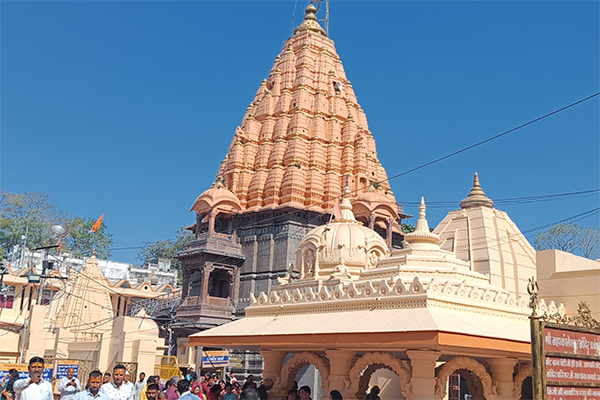
Among all the temples in Ujjain, there is none that is greater in faith and religious importance than Mahakaleshwar Temple. This temple is one of the 12 Jyotirlinga temples of Lord Shiva in India. Legend tells us that the lingam is self-originated and was not made by any man or woman. That is why this shiv linga is called Swayambhu shiv linga. The unique thing about this shiv linga is that energy currents flow from within the shiv linga and no chants are required to initiate energy. The idol of Lord Mahakaleshwar faces the south direction. This is a very unique feature and is important in tantric traditions. The idols of Ganesh, Parvati, and Kartikeya face the west, north, and east directions. Mahakaleshwar Temple has a huge courtyard, and the design and architecture of the temple itself are based on various architectural styles. Carvings, decorations, structures, and idols are exceptional. Bhasma Aarti is an event that you should not miss in this temple.
Kal Bhairav Temple
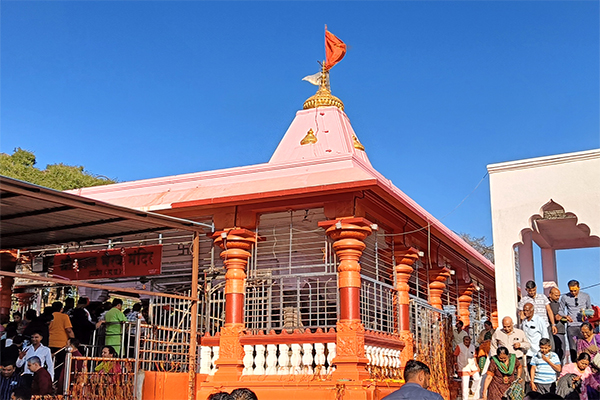
Bhairav is a very fierce form of Lord Shiva, and Kal Bhairav is the lord of all the eight Bhairavas. Kal Bhairav Temple is one of the famous temples in Ujjain, which is dedicated to Kal Bhairav. This temple believes in and practices the Tantrik traditions, which are very occult practices related to black magic. The shiv linga here is worshipped in the form of Kal Bhairav. There is an idol of Nandi, the sacred bull of Lord Shiva. Mahashivratri is a festival that is celebrated with great vigor and festivities in this temple.
Harsiddhi Mata Temple

This temple dedicated to Harsiddhi Mata is also one of the 51 Shakti Peeths of Sati. According to mythology, the elbow of Sati fell at this place. King Vikramaditya built this temple. The temple today, stands on the banks of the holy river Kshipra. Three other goddesses are also worshipped along with Harsiddhi Mata. These three goddesses are Annapurna- the goddess of nourishment, Mahasaraswati – the goddess of knowledge, and Mahalakshmi – the goddess of wealth. This temple has a distinct Maratha architecture.
Mangalnath Temple
In Ujjain, Mangalnath Temple is one of the famous temples which you should visit. The temple idol is Mahadeva who is also the guardian deity of Ujjain. Mangalnath Temple is one of the temples which is very important from a Hindu astrology point of view. The Tropic of Cancer passes through the temple. Mangalnath Temple is of special interest to Hindus. Mangalnath Temple is the birthplace of the planet Mars, which is also called Mangal in Hindu mythology. The temple was an important center of astronomy and gave clear views of the night sky and celestial objects.
Chintaman Ganesh Temple
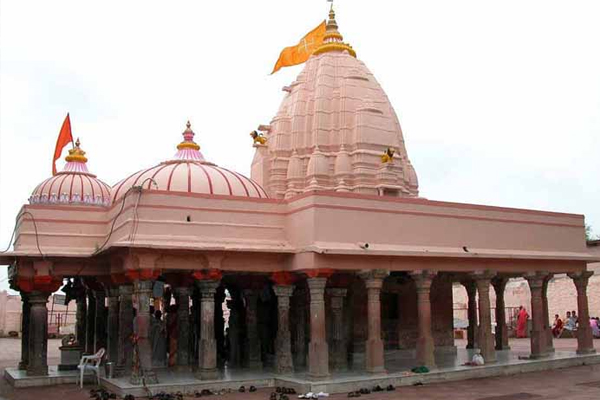
This temple called Chintaman Ganesh Temple is dedicated to Lord Ganesh and is one of the famous temples in Ujjain. Chintaman Ganesh Temple is very close to Mahakaleshwar Temple. The idol of Ganesh is worshipped as Chintaman, meaning one who removes all our worries. The amazing thing about this temple is that Lord Ganesh is worshipped in three forms – Chintaman Ganesh, Ichhaman Ganesh, and Siddhivinayak. All these three forms of Ganesh are the reason why this temple is very unique in Ujjain. Chintaman Ganesh removes worries, Ichhaman Ganesh fulfills all desires, and Siddhivinayak showers one with fame and wealth. The idol is a self-manifested one, meaning that no person has consecrated the idol. On the contrary, the idol appeared itself. There are idols of Riddhi and Siddhi, on both sides of the Chintaman Ganesh idol. The temple construction is very old and was built in the 11th or 12th centuries. According to legends, Sita, who was the wife of Lord Ram, established the temple here during Ramayana times. The temple was renovated by Queen Ahilyabai and again by the Parmar rulers.
Gopal Mandir
Gopal Mandir is a temple of Lord Krishna in Ujjain. The temple was built early in the 19th century. The marble construction of this temple is wonderful with arched gateways and beautiful carvings on the pillars. Vaija Bai, wife of the Maratha king Daulatrao Scindia built this temple in 1901. There is an idol of Lord Krishna flanked by silver-plated archways. There is a huge courtyard with pathways for circumambulation and the spire is made of marble stone. There are idols of other Hindu deities such as Shiva, Parvati, Garuda, etc. The main attraction of this temple is the silver door studded with jewels. This door was looted by Mahmud of Ghazni but was later restored in the temple by Mahadji Shinde. Janmashtami is celebrated with great zeal and devotional songs in this temple.
ISKCON Temple
ISKCON Temple is also called Shri Radha Madan Mohan Mandir. This temple is one of the best temples that you can visit in Ujjain. The marble stone used in the construction of this temple is the same stone that was used in the construction of the Taj Mahal in Agra. The colorful and highly decorated idols of Shri Radha Madan Mohan, Sri Krishna Balaram, and Sri Gauri Nitai are a beautiful sight. The idols are adorned with jewelry, flowers, garlands, and decorative ornaments. Priests chant mantras and devotional songs are sung with great fervor in this temple. The garden around the temple is a peaceful relaxing place.
Chaubis Khamba Temple
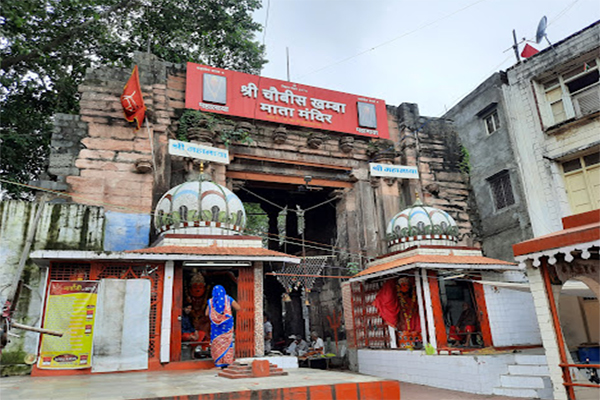
This is another very famous temple that you can visit in Ujjain. The Chaubis Khamba Temple dates back to the earliest periods of Indian history. It was built back in the 9th or 10th centuries. The temple was an entrance to the Mahakal Van, which was a big forest that existed in Ujjain more than 2,300 years ago. The temple is called due to the 24 pillars. There are magnificent idols of the guardian goddesses of this temple called Mahalaya and Mahamaya. There are beautiful carvings with inscriptions.
Bade Ganeshji ka Mandir
Among the famous temples in Ujjain. Locals worship the idol of Bade Ganesh Temple with great devotion. The temple is very close to Mahakaleshwar Temple. The idol of Lord Ganesh is among the largest statues of Lord Ganesh. Therefore, the people of Ujjain also call this temple by the name of Bade Ganeshji ka Mandir. The most amazing thing about this idol of Lord Ganesh in the temple is that it was made using bricks, lime, and sand. Spice of jaggery and fenugreek and water from all the pilgrimage sites was used in making the idol. Gemstones, pearls, rubies, gold, silver, copper, and many other metals were used in the construction of the idol. There is a statue of Panchmukhi Hanuman in the temple and an idol of Lord Krishna.
Gadhkalika Devi Temple
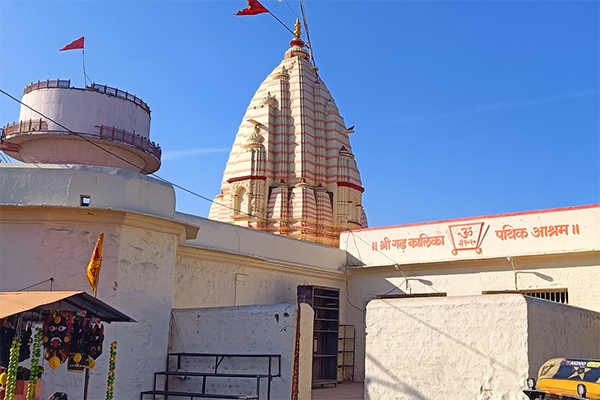
This is one of the most ancient temples in Ujjain. The deity of this temple is Kalika Devi, and the famous poet Kalidasa worshipped this deity in this temple. The goddess was so pleased with his devotion that she gave creative energies to the poet Kalidasa. It is said that Kalidas uttered the first composition devoted to Goddess Kalika here at this temple spontaneously without any education about poetry. This temple is one of the 51 holy Shakti Peeths of Devi Sati. According to Hindu legends, the lips of Goddess Sati fell here. King Harshavardhana constructed this temple during the 7th century. There are various idols of goddesses in the temple, besides the main idol of Kalika Mata.
Navgrah Shani Mandir
This temple is one of the rarest of its kind and it is in the city of Ujjain. The Navgrah Shani Mandir is dedicated to all nine planets of the Hindu astrological chart. These planets are together called Navgrah and these are Surya, Chandra, Mangal, Budh, Guru, Rahu, Shukra, Ketu, and Shani. This temple is almost 2000 years old and the only temple where Lord Shani is worshipped in the form of Lord Shiva. The temple is situated on the banks of the Kshipra river and is a very sacred temple in the whole of Ujjain. Shani is also known as the planet Saturn. In Hindu astrology and mythology, Shani is a very powerful god who can make you wealthy and also punish you for bad deeds. Saturday is the day of Shani and on this day, the temple is very festive with chants and shlokas being recited and devotees coming too far to pray to the lord Shani.
Ram Janardhan Mandir
This temple is very ancient in Ujjain. Mirza Raja Jaisingh built Ram Janardhan Mandir back in the 17th century. The temple is made of exceptional temple architecture and is heavily influenced by the Maratha temple architecture and construction. The temple is dedicated to Lord Ram and Lord Vishnu, who are worshipped here as Janardhan. The temple has a very eye-catching look and its walls and sculptures are wonderful to look at. The temple has some of the most wonderful carvings on stone and is a fine example of classical temple architecture. Inside are sculptures of Krishna, Balarama, Vishnu, and Mahesh (Shiva). You can see Maratha’s art and paintings in the temple complex. These idols are said to be as old as the 11th and 12th centuries.
Birla Mandir
Birla Mandir is a temple that is dedicated to the Hindu god Lord Vishnu. This temple in Ujjain is one of the many temples that are called Birla Mandir that were built by the Birla family, who are the leading industrialists and philanthropists of India. The temple is famous for its impressive architecture and beautiful carvings on stone. Gardens and fountains surround the temple and evening are the best time to visit the temple.
Places to visit in Ujjain
Perhaps some places are not meant to be temples as such, but these are among the most famous religious places in Ujjain. These places are iconic monuments in Ujjain and are also famous for their ingenious architecture and sacred values.
Ram Ghat
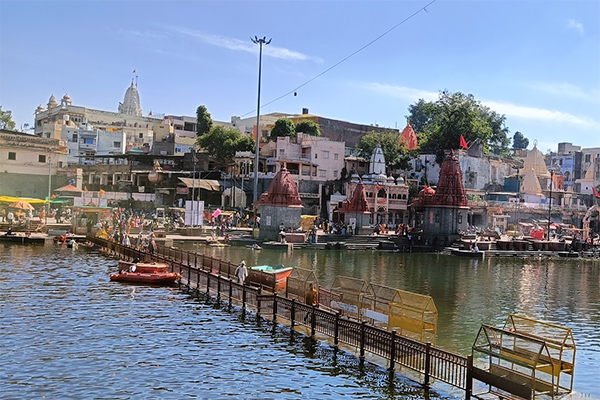
One of the most famous places to visit in Ujjain is Ram Ghat. This is a ghat that is built on the Kshipra River, which flows through the city of Ujjain. The ghat has steps leading up to the river, and devotees can bathe and have a dip in the holy waters of the Kshipra. Ram Ghat is one of the oldest bathing ghats in Ujjain, and it is believed that Lord Ram, along with Sita and Laxman performed the last rites of King Dashrath here on this very ghat. Ram Ghat is also one of the places where the Kumbh Mela is held. Millions of devotees, sadhus, sages, and holy men come here to have the first dip at Ram Ghat during this epic event. Bathing at Ram Ghat is considered to be the holiest thing to do, as it purifies us and gives us freedom from all the sins that we have committed during our lives.
Sandipani Ashram
Although this is not a temple but is among the spiritual places in Ujjain. Sandipani Ashram is an ashram in Ujjain which is one of the most famous tourist places in Ujjain. Hindu mythology mentions that this ashram was once the ashram of Sandipani rishi. The sage Sandipani was the guru of Krishna, Balaram, and Sudama and these three studied here at Sandipani Ashram. Today, you can see a temple in which there are idols of Krishna, Balaram, and Sudama, along with the idol of Sandipani Rishi. There is a stone with engravings of numbers 1 to 100, which is believed to have been engraved by none other than Sandipani himself. The ashram complex also has a shiv linga and a temple called Sarveshwar Mahadev Temple. The shiv linga is said to be more than 6000 years old and it is said that sage Sandipani himself worshipped the shiv linga. You can also see the Gomti Kund in the ashram complex. This Gomti Kund is famous as Lord Krishna ordered waters from all the holy pilgrimage centers of India to collect in this pond. Devotees still drink water from the pond and take it back home.
Ved Shala
This is an astronomical observatory that was built by Maharaja Jai Singh II. This is one of the oldest and most unique places in Ujjain. There are astronomical yantras like Sun Dial, Niyati Chakra, Samrat Yantra, and many others. These instruments were made with the help of eminent scholars and astrologers of those times. These could monitor the movement of the sun and other celestial objects. Ved Shala also is a center where astronomical research and data are still gathered.
Kaliadeh Palace
Kaliadeh Palace is a wonderful palace that was built on an island in the middle of the Kshipra by the Sultan of Mandu in 1458 AD. The palace is a work of brilliant architectural marvel. The palace was built in such a way that the Kshipra flows through both sides of the palace. The waters used to flow through canals and channels. There was a temple built to worship the Sun God at the place. There were two water tanks called Surya Kund and Brahma Kund. The palace was so beautiful that Emperor Akbar and Jehangir visited this palace. The Persian style of architecture of Kaliadeh Palace is wonderful to look at.
Bhartrihari Cave
You must visit Bhartrihari Caves on your trip to Ujjain. These caves were once the place of meditation of Raja Bhartrihari, brother of King Vikramaditya. He meditated in these caves after leaving all the worldly pleasures. There are many idols of Hindu gods and goddesses inside the cave. The caves are beside the Gadhkalika Mandir and are situated on the banks of the Kshipra River. The rock-cut caves are narrow in some places and tourists have to crouch and creep to visit the caves.
Pir Matsyendranath Samadhi
Ujjain is also the Samadhi place of the famous Yogi Matsyendranath or Machhindranath. It is believed that the famous saint took Samadhi to this place. Pir Matsyendranath was the one who founded the Nath cult. He is the guru of the famous Gorakhnath, who revived the traditions of Hath Yoga as a means to gain various powers. Matsyendranath is called a Pir. A pir is a holy saint for Muslims. Hence the place is revered both by Hindus and Muslims. The structure of the monument is made of white stone and has a dome with small minarets on four sides.
Siddhavat
Ujjain is one of the places where you will find the Siddhavat. This is a banyan tree that was planted by the gods and goddesses themselves in mythological times. The Siddhavat tree is also known as Shaktibheda Tirth and is even mentioned in the Hindu Puranas. The Skanda Purana mentions that Goddess Parvati planted the Siddhavat tree. Devotees tie a sacred thread around the trunk of the tree so that they become wealthy. The tree is immensely holy and various rituals such as Pindadaan, Mokshadaan, Kalsarp Dosha Puja, and others are performed here.
Conclusion
When you visit Ujjain, these temples and places are a must-visit. You can explore any one of the various Madhya Pradesh tour packages if you want to visit Ujjain. Or, you can go on a sightseeing tour of Ujjain and visit all the above places. It is so evident that Ujjain is not to be missed at all if you truly want to visit Madhya Pradesh and its various heritage places. As a tourist, you will find Ujjain to be incredibly beautiful and worth visiting. After all, Ujjain has a historical heritage that goes back thousands of years into the mythological ages.


